Photo 1
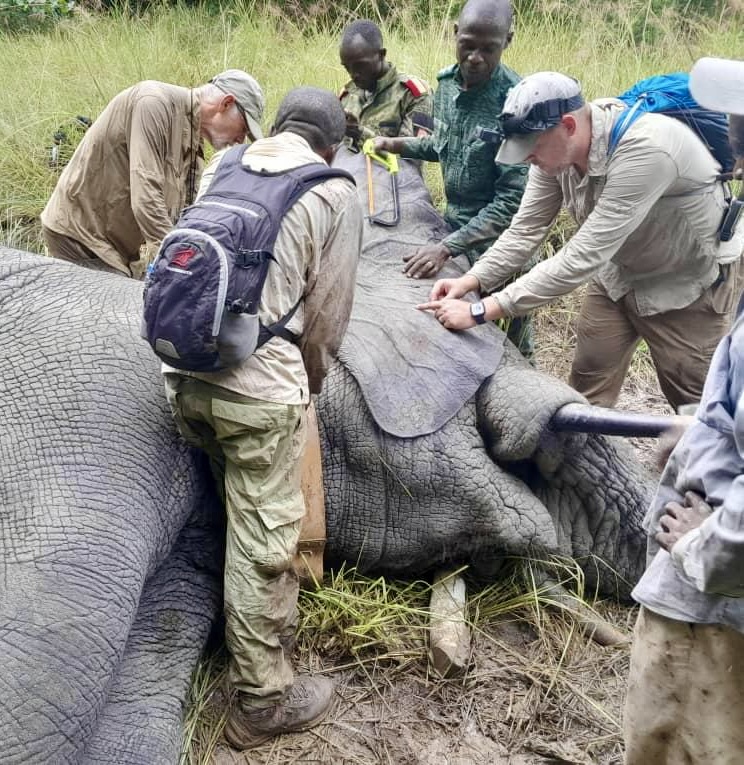
Photo courtesy of Dr. Tim Georoff
With local and visiting team members, Dr. Tim Georoff, on the right with a turquoise pack, works to place a tracking collar on an anesthetized forest elephant in Côte d'Ivoire in October.
 Listen to this story.
Listen to this story.
Dr. Tim Georoff regularly practices shooting a rifle. His aim is not to kill — quite the opposite. His purpose is to save the lives of elephants in the wild.
As part of his job as a veterinarian at the North Carolina Zoo, Georoff helps track wild elephants in the rainforests of West Africa. Tracking entails finding the elephants and outfitting them with GPS collars. To get the collars around their necks, these animals, weighing thousands of pounds, are anesthetized with darts carrying potent narcotics. Hence, the target practice.
Since childhood, Georoff has loved wildlife. He earned a veterinary degree at the University of Pennsylvania in 2004 and became board-certified in zoo medicine six years later. At the Philadelphia Zoo, he dived into conservation medicine, assisting with a snow leopard collaring project in Kyrgyzstan in addition to caring for zoo inhabitants.
Georoff joined the North Carolina Zoo a couple of years ago, in part because of its well-established conservation program. The zoo's wild elephant tracking program dates to 1998.
The VIN News Service talked on Zoom with Georoff a few weeks after he had returned from an elephant collaring expedition in the coastal African country of Côte d'Ivoire. The interview has been edited for length and clarity. Hear the full conversation here.
Let's get to the exciting part right away. How do you go about finding wild elephants in a rainforest?
Well, it's generally extremely hard work because we're looking for forest elephants in low-resource settings and potentially areas with dense forest cover. We're required to track these animals on foot to find them. This can involve up to 15 miles of strenuous hiking through really difficult terrain on a given day, and then tack that onto many days in a row.
We rely heavily also on our partners in-country to provide reconnaissance about the elephant locations and activity ahead of our trips, or missions, to best determine where we can locate those elephants.
They're looking for evidence, hopefully seeing elephants or signs of elephants. Some of that involves elephant work to mitigate human-elephant conflict. In those situations, they're often seeing the elephants or evidence of elephants in plantations or farms, raiding crops.
In the search, you're looking for, what — their footprints? Their poop? Seeing evidence of the conflicts — that's, like, crops that have been stepped on or munched?
Correct. Particularly, we're looking for their tracks and fresh feces, fresh poop. You'll hear some noises, as well, but not until you're much closer. Sometimes, the environment on the trail is disturbed, such as broken branches.
You'd think that the elephants would be rather easy to find and leave a lot of evidence of their presence, but, especially in dense forest, you'd be surprised how little obvious evidence they leave.
The poop you're looking for must be fresh, right? So that you know that they're near?
Yeah. Our goal is to find fresh poop, and what we mean by "fresh" is something that's estimated to be four hours old or less. If they're a day or more ahead of us, it's really difficult to catch up to them, even when they're stopping and eating.
It's not always easy to tell how fresh something is. Usually, the fecal boluses are mostly intact, and they have a pretty strong odor, like stronger than — you know, poop doesn't smell good to begin with. Proximity to maybe fresh urine and often some small flies will be indicators [of freshness]. And sometimes there are tracks and other evidence around that. You piece those all together, but it's often just a best guess.
You mentioned support folks. How many people are on the team?
The minimum number of people is 10. You need that number of people to carry all the gear. That includes darting equipment, first aid, human emergency exposure supplies, the collaring materials — the collars for the elephants are quite heavy — and even life support equipment for elephant anesthesia.
You also minimally need that number of people to help move and reposition an elephant to make sure they're in the correct position for breathing during anesthesia.
Is the work potentially dangerous?
Quite dangerous, actually. We are trying to approach elephants most of the time on foot without any real protective barrier to get close enough to be within a reasonable range for a darting attempt. And that's usually about 20 to 30 meters from the elephant. The elephant or elephants are all capable of charging and severely injuring or potentially killing someone.
Photo 2
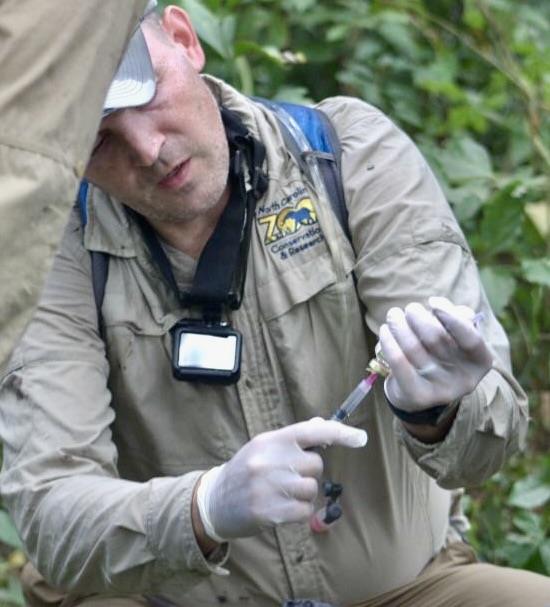
Photo courtesy of Dr. Tim Georoff
Dr. Tim Georoff prepares the anesthetic reversal as part of dart preparation.
And there are limited areas that you can hide behind, maybe a big tree. We do try to position ourselves between barriers. A person can't outrun an elephant running at full speed.
We also use highly concentrated ultra-potent drugs — narcotics — to immobilize elephants using a 2- to 3-milliliter-volume dart. These also present a hazard, although we use very strict handling protocols to mitigate that risk.
We also don't have any control with regard to who or what else is in the forest with us at any given time.
Who else is out there?
There's poaching pressure on elephants. That involves people that may not have a lot of money and are looking for elephants as a resource. They could be armed. And there are potentially other dangerous animals. Did I mention venomous snakes?
Can the elephants detect that you're coming?
We try to be as stealthy as we can, but they obviously can know about our presence. Certainly, sounds and smells and things like that can make them either want to charge or to move away from us. Usually, they're just trying to move away. But it really depends on the animal.
We always hear about how social elephants are. Will family or friends come to the rescue of an elephant who's being targeted?
Yes. That's something you need to be aware of at all times. Sometimes another herd member can run to the aid of an anesthetized animal or charge personnel.
Some family groups may be traveling with neonatal or juvenile elephants. Sometimes, more than one elephant needs to be darted at the same time for safety.
We don't put collars on juvenile elephants. That largely is because they're going to outgrow the size of a collar, and it wouldn't be safe.
How do you make sure the elephant stays safe after being darted? I imagine you don't want it to just go clunk! onto the ground.
Georoff on bridge
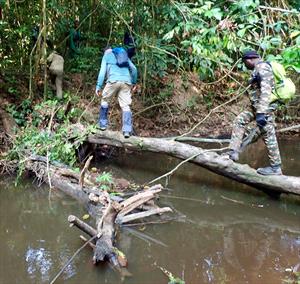
Photo courtesy of Dr. Tim Georoff
Members of the elephant collaring team use a log bridge to cross a river in the rainforest.
Unfortunately, you don't have a lot of control over where the elephant will land and wants to go after it's darted, which is one of several inherent hazards to this kind of work.
Elephant anesthesia in a zoo setting is much more controlled. And in a zoo setting, you can use operant conditioning or positive-reinforcement conditioning to have an animal lie down. We can't do that in the forest.
Now, much of the forest is softer than the indoor surfaces where you might try and anesthetize the animal in the zoo. You often try to put down more matting and things like that.
In the field, we'll try to avoid darting elephants near large rivers because the elephant may run into the water following darting. They actually can run quite a bit after induction, even though these are quick-acting drugs. They can run for one to two kilometers. And if they're close enough to a river, they're at risk of drowning unless we can get in there and lift their trunk out of the water. About 70% of elephant respiration occurs via their trunk, so it's important to make sure that the trunk is clear and unobstructed during anesthesia.
Inclines are also a problem. If an elephant happens to fall facing the wrong way on a hill with their head down, there is a tremendous amount of pressure. They really can't breathe in that situation, and unless we can get our team in there — this goes back to why you have 10 people — if we can't get in there and move that elephant around, that is an emergency situation where we need to consider reversing the animal's anesthesia, even if it means we don't do the collar.
The safety of the elephant takes precedence over just about everything else we're trying to do, with the exception of our own team's human safety.
Everybody knows elephants are big. But how big are we talking?
Forest elephants are a little smaller than the savanna elephants that you think of in zoos. But you're talking about something that is between 3,000 and 3,500 kilograms. That's around 6,500 to nearly 8,000 pounds. So what's the difference between that and a savanna elephant that might be 9,000 or 10,000 pounds? I mean, they're a little smaller but still quite large.
The collaring itself, how long does that take? You hang around afterward, it sounds like, to make sure that the elephant wakes up and can move off safely.
The actual collar placement can be accomplished rather quickly, although sometimes it's difficult to slide portions of the collar someplace where you want it ... to kind of shove things under a very heavy, you know — just imagine the heaviest thing, and trying to put, like, pieces of leather underneath that.
Photo 3
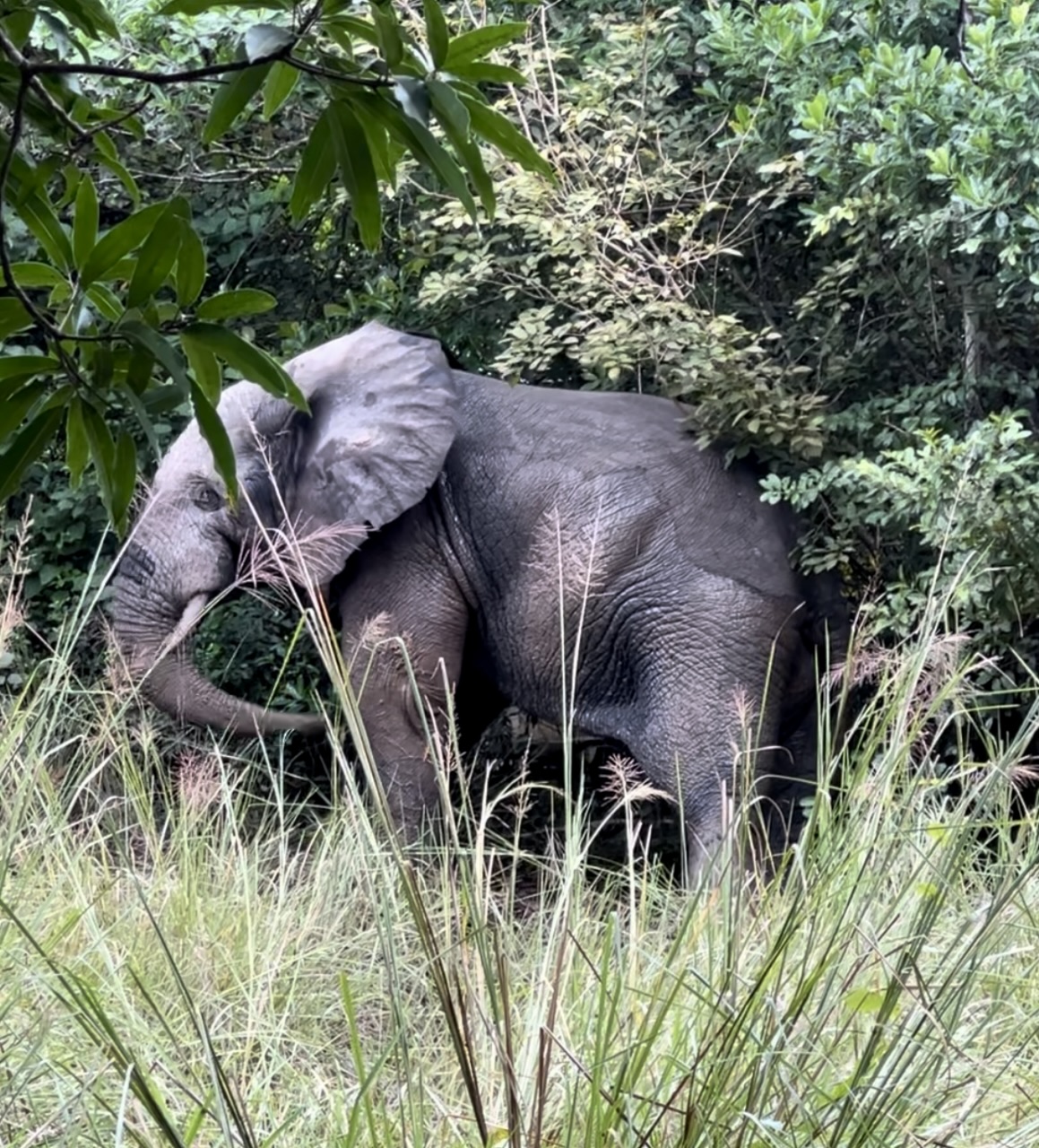
Photo courtesy of Dr. Tim Georoff
A forest elephant (the one shown in first photo being collared) awakens and rises.
We try to accomplish that in 20 to 30 minutes or less. And yes, as you mentioned, we obviously stick around for the entire procedure.
We use reversible anesthetics. I mentioned some of the disadvantages of the those ultra-potent narcotics. One of the advantages is they're reversible. Once we administer the reversal, we will observe the animal from a safe distance, often behind or in proximity to a tree or some type of physical barrier in case the animal rouses and charges in our direction.
That process for recovery usually takes somewhere between five to 15 minutes.
On the trip in October, how many elephants did you come upon?
I split the mission with Dr. Mike Loomis, who is basically the creator of these collaborations and the most experienced veterinarian anesthetizing elephants in the world, or one of them, certainly of forest elephants. We were able to do two, and we had two collars. I was there for one elephant.
In a given trip, you often don't find elephants. In fact, there's a lot of time spent not catching, not seeing, not finding. You're very lucky if you're seeing them daily and come in contact with at least one elephant, let alone two.
What can you learn by collaring elephants, and how exactly does that protect them?
Most elephant conservation programs are attempting to conserve elephant populations and their habitats ... identifying key habitat, hotspots and corridors; identifying new habitat that would allow expansion of the protected areas or create new protected areas.
Map
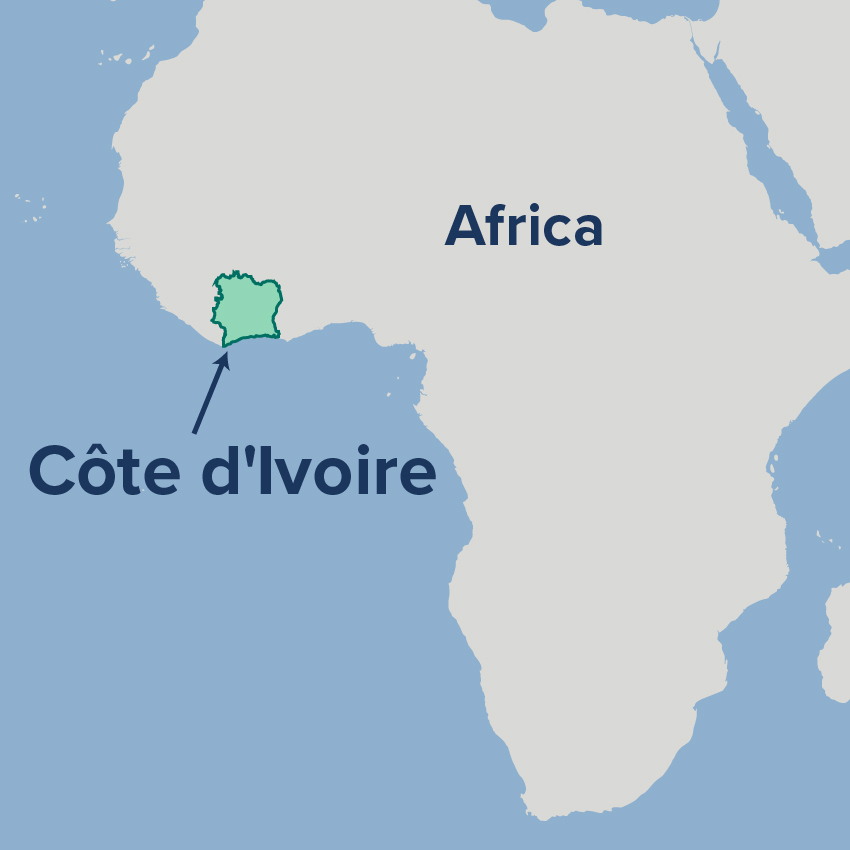
[We] then help increase the effectiveness of anti-poaching efforts and increase the understanding of their biology and where they're using land, [enhancing] our understanding of elephants and where they're going and what they're doing, to help mitigate some of that human-elephant conflict that we were talking about.
Also developing teaching materials to sensitize and educate stakeholders — people that are involved with elephants in their habitats, people that share the environment near or with elephants in their environment, and then also developing knowledge to help inform policy decisions.
How collars work with that is they can obviously provide a steady stream of data over a long period of time. The data collection requires minimal use of human resources in the field, which is really critical, particularly in these parts of Africa. You don't need a lot of infrastructure.
The elephants can be tracked over really long distances across international boundaries. That would be basically impossible without the use of a collar.
But a collar is just a tool. It's not the goal in and of itself. It's just one aspect of trying to help understand what elephants are doing, where they're going, what they need and how they're interacting with people in the environment.
How many, at this point, are collared?
Currently, with our partnership in Côte d'Ivoire, we've collared five elephants. Not all of the collars are necessarily working at the same time due to a number of factors, such as the date of placement and battery life.
Over the course of this project, North Carolina's new veterinary team, led by our former chief veterinarian, Dr. Mike Loomis, who I mentioned before, he's collared somewhere between 40 to 50 elephants combined, in Central and West Africa, over a number of countries over the past 25 years.
How long does that battery last, then?
It depends on the model of the collar and on how frequently you're asking for data. We get spoiled because so many things are real-time access. The reality is that those collars with the batteries would probably not last but six months [if used to track in real time], which isn't enough time for us to get a lot of good information. We typically program the current models to leave data uploads every 48 hours. Those collars could maybe last for five years. And with the newer collars, they can do daily uplinks. The better the batteries get, the closer we get to real-time monitoring and tracking, which would be awesome.
We talked a little bit about the savanna elephants that you see marching through documentaries. But these are different?
Yes, the classic savanna elephant versus what we're talking about are African forest elephants. They're different species. It's Loxodonta cyclotis. They look different — although the differences are fairly subtle to most people that are unfamiliar with the species. There's only one forest elephant housed in a zoo in the entire world, so most people have never seen one. All of the African elephants living in U.S. and European zoos are savanna elephants.
Forest elephants are listed as critically endangered by the IUCN, which is the International Union for the Conservation of Nature, the organization that determines a lot of those criteria.
As you know well, I'm sure, keeping elephants in zoos is controversial. What are your thoughts on the pros and cons of having elephants in captivity?
One thing that I've realized in working not just with elephants but with many different wildlife and non-domestic species all over the world is that animals will never not be influenced by humans and human activity in some capacity, both in zoos and in the wild.
Most of the concerns surrounding elephants in zoos revolve around their welfare. The care in most zoos accredited by the Association of Zoos and Aquariums has evolved quite a bit over the past decade, with a high emphasis on science around elephant health and welfare. The animals receive high-quality medical care, and nearly all of their health care and husbandry is facilitated through positive reinforcement training.
Many zoos have opened larger, more spacious exhibits or closed down smaller ones and moved elephants to larger zoos that have those facilities or to several elephant sanctuaries that people are well aware of. So how we think about elephant care has changed.
At the North Carolina Zoo, we have a tremendous amount of space. The zoo is more than 2,600 acres. Our elephant habitat is one of the larger ones in U.S. zoos. But to be honest, few zoos or any captive habitat provide the same amount of land acreage that may be available to a free-ranging elephant.
However, while some wild elephants may have free access to a ton of space, others maybe less so. Not every elephant lives in a protected reserve. In fact, many do not, and they're coming into contact and conflict with people over resources in and around habitats.
Elephants in the wild face a tremendous amount of human pressures, both directly and indirectly. Ivory poaching remains a significant problem despite law enforcement attempts to curb it. Elephants can be killed sometimes, leaving orphan calves that would not survive without human intervention or care.
Indirectly, economic development or demand for increased forest resources has led to major declines in habitat, which is where we're getting this human-elephant conflict coming into play.
Some of the elephants we work with are living in limited, fragmented patches of forest. So they don't have this big swath of land. Bigger than a zoo, but not what you would necessarily think of ....
So yeah, there are many positives to elephants and all animals living in the wild. But I would say often, this is idealized. Many elephants can't just live anywhere they want to.
How do you juggle a demanding job and trips to faraway places with your responsibilities at home?
Not easily. It starts with my wife being very understanding. It's tough to be away from your kids, and I miss them when I'm away. All that helps to motivate me, you know, when you're on long, hard days and you're not having success finding an elephant — which is more frequent than you're finding an elephant. That is the nature of fieldwork.
I'm pretty involved with my kids' stuff when I'm home, which is most of the time.
The other component to this is the zoo, and particularly the veterinary team here, is very supportive of the work, and that's critical because that's my day job. The zoo always, always has veterinary coverage. When one of us is away, there's always specialist care here. I couldn't do any of this without that level of support.
That allows me to use my specialized skills and platform as a zoo veterinarian to directly impact species conservation, which, to me, is a really, really important aspect of what I can offer as a veterinarian.